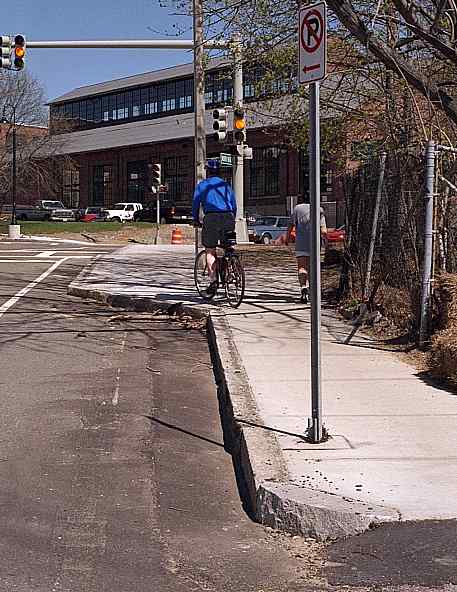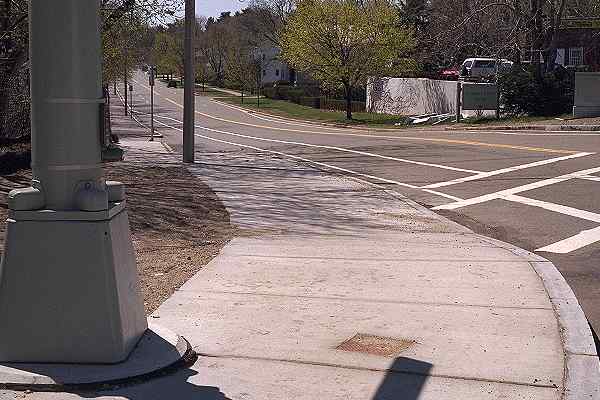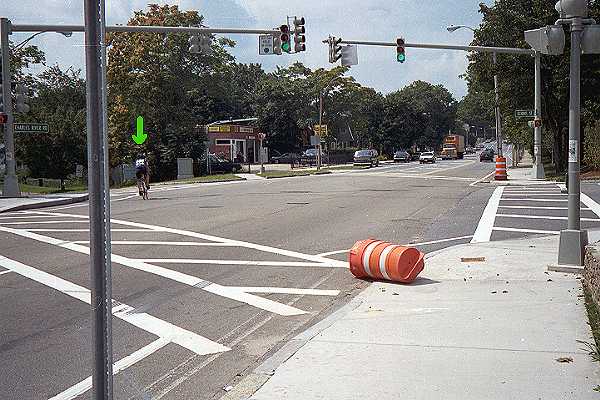Top: Home Page
Up: Table of Contents
Previous:
Next:
NORTH BEACON STREET AND CHARLES RIVER ROAD, WATERTOWN: INTERSECTION
DESIGN 101
|
Pass your mouse pointer over the image
to see how
the same intersection looked before the reconstruction
(and note the bicyclist in the older photo, making
a vehicular left turn onto Charles River Road)
| The bicycle path, constructed in 1980 according to the lax standards of that time, was
originally 8 feet wide, between the curb on one side and the chain link fence on the
other. Now the available width of the path is less than 4 feet. The engineer who designed
the intersection apparently applied sidewalk design standards to the biycle path. The bicyclist on the path in the photo below is headed into a pedestrian neckdown at the intersection, which shortens the roadway crossing for pedestrians, but which requires bicyclists to thread their way past a lamppost and a traffic light pole, and puts the bicyclists into conflict with pedestrians waiting to cross in the crosswalk. In the photo, the pedestrian behind the no parking sign post is headed for an informal dirt track to the right of the lamppost. This is the route the bicycle path originally took before the intersection was reconstructed, and if it had been maintained, bicyclists would have smoother going and could avoid mixing with pedestrians on the corner or threading around the lampposts. In the photo, the pedestrian arrived first and is taking the shorter route, diverting the bicyclist onto the longer one. |

| Also note the new asphalt where the street was widened, and the newly installed, sharp
granite curbstone which, like the old one, intrudes into the width of the bicycle path at
the driveway. In the next photo, we are looking across the crosswalk (from right to left in the photo above). The curb cuts and crosswalks are significant improvements for pedestrians, but the bike lane treatment at the intersection is highly unusual and incorrect. The bike lane is striped to accommodate only right turns. There is no acknowledgement that bicyclists go straight or turn left, except perhaps by going around the corner and then swerving left into the crosswalk in front of right-turning motor vehicles. |
![]()
The photo below looks back into Charles River Road from the intersection. The crosswalk is at the right. Unlike the curb cut at the Watertown Yacht Club driveway, the one at the crosswalk is smoothly graded -- a standard feature for wheelchair curb cuts. It's nice to have a wheelchair curb cut here considering all the other hazards that could put people into wheelchairs. |

| In the next photo, we have backed up across North Beacon Street to look at the entire
intersection. The traffic light pole at the extreme left of the photo below is the same as
the one in the foreground of the photo above. The bike lane striping goes around the corner to the right on all four corners of the intersection. I don't think any blame attaches to the barrel which has fallen into the road -- such things happen. The most common left turn movement in this intersection is from North Beacon Street to Charles River Road. This maneuver is now easier and safer here than it was before, thanks to the new left turn lane and traffic signals. Child and novice bicyclists prefer to ride on the bike path, but adult bicyclists generally prefer to make left turns as drivers, rather than as pedestrians -- it is much faster than going around as a pedestrian on the crosswalks. Only the left turn maneuver from the left turn lane leads smoothly to the new bike lane on Charles River Road. The bicyclist in the next photo (under the green arrow) is making this maneuver. |

| In the next photo, we have backed up even more. The intersection is in the background, with Charles River Road branching off to the left. The section of North Beacon Street between the river and Charles River Road has been reduced from four to two lanes. The darker strips of pavement are where earlier lane line markings have been removed.. The reduction in the number of lanes has made room for a special left turn lane and for bike lanes. However, the bike lane at the right is not dashed to indicate bicyclists' merging into the left turn lane. This left turn is one of the most common movements for bicyclists in the intersection. |
![]()
| What lessons does this intersection hold? 1) The basic features of good intersection design -- here, the traffic lights and left turn lanes -- work to the advantage of all travelers. Before the reconstruction, this intersection had no protected crossings for pedestrians, and the left turn from North Beacon Street onto Charles River Road also was often difficult for drivers. Only bicyclists and pedestrians on the bike path had a relatively easy time. 2) Bicycle design is not the same as pedestrian design. Bicyclists may legally operate either as drivers or as pedestrians. The more experienced bicyclists prefer to operate as drivers, because this is much faster and reasonably safe for them. If bicyclists and pedestrians must be mixed, then the facility should be designed to bicycle standards. Bicycle and pedestrian conflicts should, however, be avoided wherever possible, because bicyclists can not travel safely at their normal speed among pedestrians. Pedestrian neckdowns can sometimes narrow road width excessively for bicyclists (though this intersection has avoided that problem). 3) Bicyclists and pedestrians are beginning to be taken into account more in traffic engineering. The willingness to consider that a roadway might be overbuilt, and to reduce the number of lanes so that bicyclists and motorists do not have to share a narrow lane, is an example of this trend. 4) Though design guidelines exist, there is a lot of work to do in instructing civil engineers in how to design for bicyclists. |